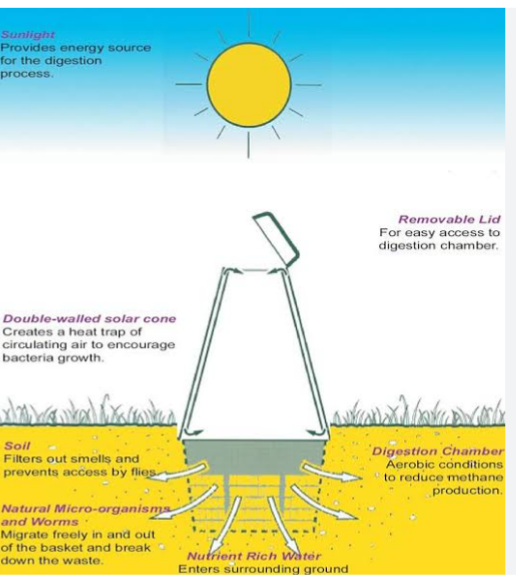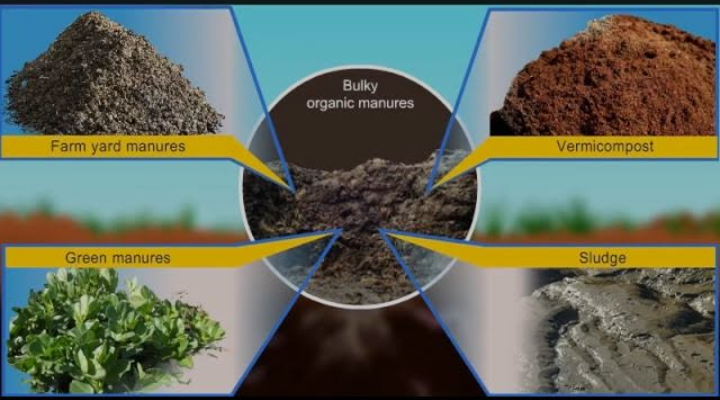
Manure is the decomposed form of dead plants, animals and animal excrement which is applied to the soil to increase production. The animal excrement are usually mixed with straw or leaves. The amount and quality of the excrement depend on the animals feed. Good manure contains more than just excrement and urine. Straws and leaves are added and it is aged. Aging is necessary to retain all of the nutrients. Using aged manure is an ideal method to retain and increase soil fertility.
Manures especially animal manure should be left to decompose before applying to crops, as it will burn the plant if it comes in contact with the plant. Poultry droppings makes the best manure, followed by goat droppings, then sheep and cattle dung. Animals that feed on good quality feed produce the best quality manure.
GOALS OF APPLYING MANURE
Manures are natural form of fertilizer and is cost-effective. It’s main goals are as follows:
1. To increase the level of organic matter
2. To increase the available nutrients
3. To improve the structure( aggregate formation) and water retension capacity of the soil.
The nutrients in animal feeds are partly stored in the animals bodies. By spreading their excrement and urine onto a field, the nutrients are made available to the plants. The manure add organic matter to the soil, thereby improving the soils structure and it’s capacity to retain water. Soil organisms are also stimulated, which improves the soil structure.
If cattle graze freely, they can gather their own food, and their excrement is thus spread randomly over the field. A great deal of nitrogen can be leached or volatilized. Potassium is also partially leached. To use the excrement as manure, it is thus better to keep the animals in a stable. The excrement are then collected and cured or aged before spreading on the field. The nutrients in the manure can then be protected from being leached and lost.
SOURCES OF MANURE
Manures are obtained from various sources. The different sources of manure include:
Cattle dung, urine, and slurry from biogas plants,
human waste such as human urine, night soil, sludge, sewage, domestic waste. Droppings of poultry, goat and sheep, Waste from the slaughterhouses such as bones, meat, horn and hoof meal, fish waste. By-products of agricultural industries, Crop waste and Weeds.
IMPORTANCE OF MANURE.
1. Livestock manure is rich in nitrogen, phosphorus, and potassium.
2. Manure is highly rich in organic matter and humus and thus improves the soil fertility. These are better in the long run
3. It does not cause any pollution.
4. It is a valuable and renewable resource
5. Manure is an ideal soil amendment. When it is applied to the agricultural fields it acts as a field residue.
6. Farmers can sell the manure to people who need to improve their soil fertility. Thus, it can bring income to farmers.
7. They add to the overall soil ability and sustainability.
8.Manure increases the water holding capacity of the soil.
9. The organic content of the soil can also be improved by applying raw manure like biochar, compost, etc.
10. Different types of manure contain about 26% solid. The solid and liquid portions are segregated and the solids are used for bedding. 11. The carbon content and other elements can be used to produce different biofuels. Manure also contains a large number of fibres. The undigested animal feed, straw, sawdust, or other bedding contains a lot of fibre.
12. Manure is environment-friendly and contributed to increase in food production. Use of manure improved the fertility of the soil and increased the yield of the crops.
TYPES OF MANURE
There are different types of manure. This types are of different classes
1. Classification Based on the density of the nutrients, manures can be divided into bulky organic manures and concentrated organic manures
2. Manure produced based on any living being and animal waste. These are the green manure, farmyard manure, and compost manure.
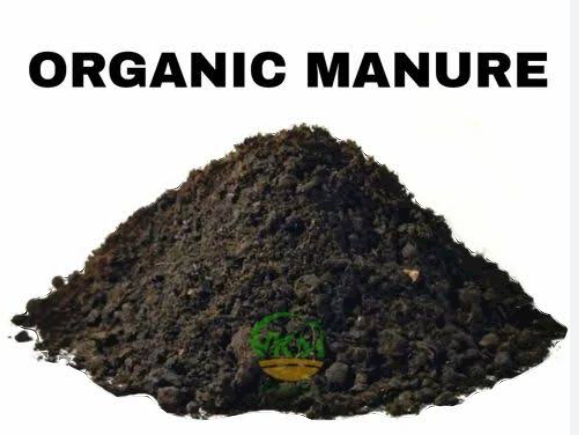
Manures can be grouped into bulky organic manures and concentrated organic manures. They differ based on concentration of the nutrients.
a. BULK ORGANIC MANURE:
Bulky organic manures contain small percentage of nutrients and they are applied in huge quantities. Farmyard manure (FYM), compost, straw, hay, Sawdust, Night Soil, Sewage and Sludge, Vermi-culture Technology, Green Manure, Oil Cakes. Green-manure and farmyard manure are the most important and widely used bulky organic manures. Use of bulky organic manures has several advantages: They supply plant nutrients including micronutrients. These types of manures are usually applied in large quantities to soil to improve its structure, water holding capacity, and fertility.
b. CONCENTRATED ORGANIC MANURE:
Concentrated organic manures are made from raw materials obtained from animals and plants, e.g., oil cakes, blood meal and fish manure, meat etc which contains iron, calcium, nitrogen and phosphorus. Characteristics features of concentrated organic manure: greater Water holding capacity, high concentration of nutrients available for plant use etc.
c. GREEN MANURE
Green manures are crops grown for the main purpose of ploughing them under. They help increase soil fertility through the incorporation of nutrients and organic matter into the soil. Leguminous plants such as clover are often used for green manure. They fix atmospheric nitrogen using Rhizobia bacteria found in the root nodules of the legumes.
Other types of plant matter used as manure include the contents of the rumens of slaughtered ruminants, weeds, spent grain (left over from brewing beer) and seaweed.
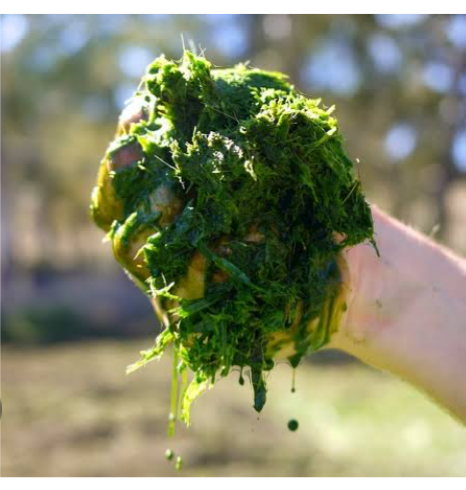
Using green manure increases the amount of organic matter in the soil. This type of manure has deep roots in the ground. These aid in weed management and the avoidance of soil erosion.
d. FARMYARD MANURE
These are animal manure that consists of animal feaces. Common forms of animal manure include farmyard manure (FYM) or farm slurry (liquid manure). FYM also contains plant material like straw, which has been used as bedding for animals and has absorbed the feaces and urine. Agricultural manure in liquid form, known as slurry, is produced by more intensive livestock rearing systems where concrete or slats are used, instead of straw bedding. Manure from different animals has different qualities and requires different application rates when used as fertilizer. The difference in quality is due to the fact that Animal manures are isually adulterated or contaminated with other animal products, such as wool (shoddy and other hair), feathers, blood, and bone. Livestock feed can be mixed with the manure due to spillage. For example, chickens are often fed meat and bone meal, an animal product, which can end up becoming mixed with chicken litter. Example of animals that produce such manure include: horses, cattle, pigs, sheep, chickens, turkeys, rabbits, and guano from seabirds and bats all have different qualities.
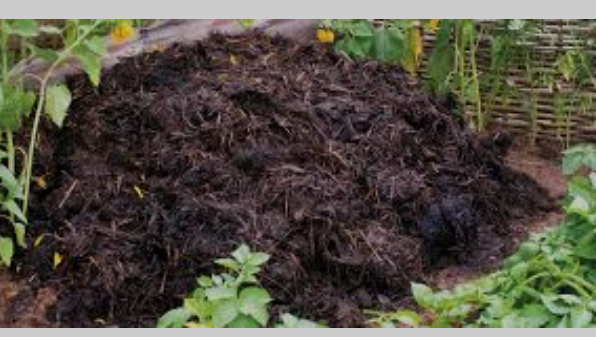
Farmyard manure improves soil texture and is used as a natural fertiliser. It increases the ability of the soil to retain more water and minerals. It also increases mineral delivery and plant nutrition by increasing soil microbial activity.
e. COMPOST MANURE
Composting is a controlled, aerobic (oxygen-required) process that converts organic materials into a nutrient-rich, biologically-stable soil amendment or mulch through natural decomposition. It is a mixture prepared by degradation of the dung of farm animals, crop residues, farm wastes and some other organic debris. The end product is compost. Microorganisms assist in the decomposition of the materials mixed to form the compost pile during the composting process. The degradation is done either in exposed pits or is covered by a mud pack to prevent waterlogging during the rainy season.Compost contains three primary nutrients needed by garden crops: nitrogen, phosphorus, and potassium. It also includes traces of other essential elements like calcium, magnesium, iron, and zinc. Instead of relying on synthetic fertilizers that contain harmful chemicals, composting offers an organic alternative
It improves soil structure as well as water and nutrient retention. As a result, it increases plant health by increasing nutrient value.

CONDITIONS AFFECTING THE PRODUCTION OF MANURE
In areas with heavy rainfall ( humid tropics), farmers often do not rear cattle in high number to produce sufficient amount of manure. However, good alternatives are available in the form of green manure, intensive fallow period, poultry droppings and agroforestry.
In areas with less rainfall, and a dry season (sub humid area), conditions are better for raising cattle and less manure is needed for a substantial improvement of the soil fertility, because the organic matter decomposes slower.
In semi arid areas, it is more difficult to keep animals in a stable, because feed is scarce, and it is not possible to grow the feed. One option in this situation is to allow the animals to graze during the day, and to keep them in the stable by night. The manure is then kept in a manure cone to keep it from drying out too fast.
KEEPING AND AGEING MANURE
Fresh stable manure is not very suitable for immediate use. The C:N ratio of fresh manure is high, which can cause nitrogen immobilization. If the organic matter is very rough, that is, it contains a lot of fibre and few fresh, juicy leaves then the C:N is high. Microorganism then have to work hard to digest it and allow nutrients to become available to the crops. Moreover, the microorganisms also need nutrients to build up their own bodies which may exceed the amount they can generate. Also, in the initial stage of decomposition, substances are freed that can exhibit plant growth or scotch the leaves. If the manure is spread on a field empty of crops, many nutrients will be leached.
ADVANTAGES OF KEEPING AND AGEING MANURE
1. The C:N ratio decreases during ageing
2. Harmful substances that are released in the first stage of decomposition are eliminated.
3. Weed seeds are decomposed or loose their germination power
4. Few nutrients are lost through runoff or volatilization
5. Aged manure is easier to transport
DISADVANTAGES OF KEEPING AND AGING MANURE, PRECAUTIONS TO BE TAKEN
Despite the fact that aged manure is an ideal fertilizer with soil improving characteristics, it is not always used on the land. In areas with limited fuel sources, dried manure is used as cooking fuel. An alternative fuel source can be created by planting trees for fire wood as living fences or along paths. Working with manure can also be seen as dirty and inferior, and manure piles as too unhygienic to have near farmyard.
If a farmers cattle normally graze freely, then keeping the animals in a stable to generate manure will require extra labour of tethering, straw provision and cleaning out the stable. Sometimes an alternative can be to allow the cattle to graze on crop residues after the harvest, and to gather some manure from the field afterwards. Transporting manure to the field is also labour intensive. So the manure is often brought to the field at a time that is relatively labour free, like before sowing. However, if the manure is then immediately spread onto the field, the land can be too dry to properly mix with it and nutrients can be lost. It is better in this case to keep the manure in a pile at the field and to mix it with the soil just before sowing. This way the nutrients will not be leached or volatilised
MANURE CURING.
Cured manure refers to the treatment of manure to make it suitable for various purposes. It involves processes such as composting, anaerobic treatment (biogas), or aerobic thermophilic stabilization (ATS) . During
curing, the livestock faeces are allowed to stay for a period of time before use. Most cured manure undergoes anaerobic partial decomposition which helps to lower ammonia-heat generation that could damage the crop plant on application. Cured manure is not completely free from pathogens hence it should be treated or inoculated with biocontrol agents such as Trichoderma viride, Pseudomonas fluorescens, etc. Nutrient release is usually prolonged and temporarily builds the soil. Curing and ageing of manure differ from one another. Curing is a treatment process while Ageing means decomposed manure
METHODS OF KEEPING AND AGING MANURE AND RECOMMENDATION
There are a number of different ways to keep manure and to allow it to age.
1. LOOSE BOX: Keeping the animal in a stable can make production and collection of high quality manure easy. The roofs of the stable can serve as protection from rain and sun. Everyday, fresh straw or leaves are thrown into the stable as bedding materials . The animals stamp the straw into the manure. The straw or leaves also absorb the urine and nutrients. Enough materials has to be added to ensure that the mixture does not become soggy. The loose box manure can eventually reach a height of 2m, and it is sufficiently aged after 3 or 4 months. Since the layers are not equally aged, the pile must be mixed thoroughly before it is applied to a field. This method requires a large amount of straw or leaves.
MANURE PILE: Less straw or leaves is needed if the stable is cleaned every two days. The manure is used to make a manure pile, which is 2 metres wide and walled in. The pile is built in stages. One piece is piled up as quickly as possible to a height of 1.5 metres. It is then covered with earth to prevent it from drying out. Each time one piece is completed, a new piece is started, and the pile continues to grow longer. Since a new piece is added on each time, aged manure from one end can be used at the same time that new manure is added at the other end.
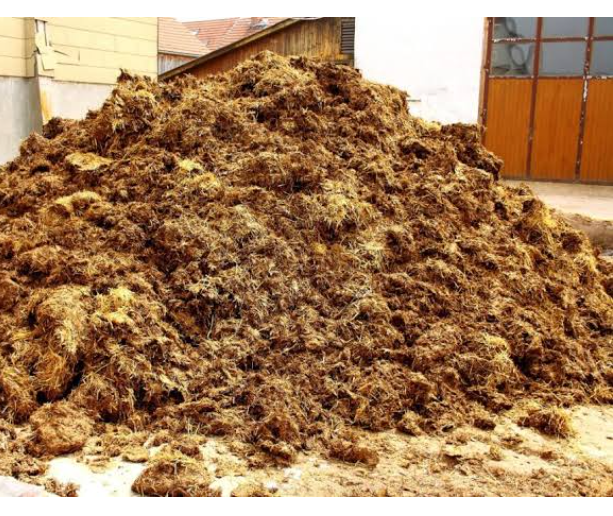
The manure must be well compacted, especially if it is very loose, and it must be kept moist. If the pile is too dry, white mould will appear, if it is too wet, it takes on a yellowish-green colour. A manure pile should be situated under a shed so that it is protected from rain and from drying out. Ideally, it should be on sloping ground so that excess moisture can drain off. Manure piles are especially suitable in wet areas or during rainy seasons.
MANURE CONE
Manure in semi-arid and arid areas contain less straw, which hinders the ageing process. An alternative that is suited to these areas is the manure cone. The manure cone begins as a circle with a diameter of 1.5 to 2 metres. Everyday, a layer of manure is added that is preferably 30 cm thick. Each layer has a smaller diameter. At a height of 1.5 metres the point is rounded off. The side surface is covered with a layer of clay, and the top is covered with a layer of straw or rough leaves to protect the cone from rain and drying out. After 4 or 5 months, the manure in the cone is ready to use.
